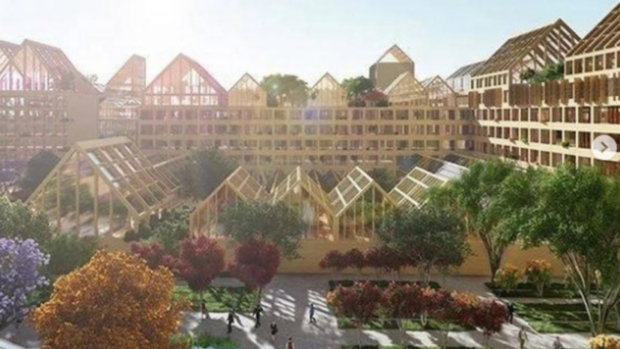This futuristic city design was conceived to respond to issues presented by lockdowns

A group of architects has come up with plans for a city that cope effectively with future lockdowns. Image: Instagram/@gphaus
Greenhouses to grow vegetables, drones to take charge of deliveries, 3D printers to produce everyday objects… These are just some of the elements in the design for an urban housing development that has been christened Self-Sufficient City.
The project by a Spanish architectural practice, which has drawn much of its inspiration from restrictions imposed in many parts of the world earlier this year to deal with the pandemic, would have no fear of another lockdown.
With their proposal, the Guallart Architects practice won a design competition to create an extensive mixed-use development in Xiong’an New Area in the province of Hubei in China, where close to half a million people were forced to endure a second lockdown in June of this year in the wake of a resurgence of the coronavirus.
With self-sufficiency integrated on the level imagined by Guallart Architects, the threat of future pandemics would be far less terrifying than it is for most of us today.
Biodiversity a major theme in future city design
In concrete terms, this involves the construction of greenhouses equipped with LED grow lights and hydroponic systems for fruit and vegetable production on top of most urban buildings. Initiatives like these are currently gaining recognition for their clever use of space as well as their optimal conservation of water.
At the same time, space should be set aside for more traditional cultivation methods, which the Spanish architects have emphasized by including dedicated gardens for aromatic herbs.
Nature is not only valued as a food source, but is also at the heart of many other aspects of Guallart’s proposal, which also makes extensive use of specific plants that attract butterflies and where every apartment is provided with its own nesting box to provide shelter for birds. Rainwater is also carefully collected and recycled for a variety of uses.
However, just because it is focused on the theme of biodiversity does not mean that everyday living in this future urban environment will be impractical. All of the dwellings are equipped with 5G internet to facilitate working from home. The plans also aim to reduce the use of motor vehicles, however, these are partially replaced by drones for the delivery of internet purchases, provisions to encourage cycling, widely available public transport and a fleet of electric taxis. Alongside all of this, the proposal also features much of the infrastructure that makes urban living enjoyable today, including a market, stores, a swimming pool and a childcare facility.
As for everyday objects that might be lacking or broken, the Spanish architects provide for co-working workshops equipped with 3D printers where these can be created or repaired without any recourse to external supplies. In short, this is an urban development that is not only respectful of the environment, but also largely self-sufficient. RGA
RELATED STORIES:
70-person rave ignoring lockdown measures shut down by police
For more news about the novel coronavirus click here.
What you need to know about Coronavirus.
For more information on COVID-19, call the DOH Hotline: (02) 86517800 local 1149/1150.
The Inquirer Foundation supports our healthcare frontliners and is still accepting cash donations to be deposited at Banco de Oro (BDO) current account #007960018860 or donate through PayMaya using this link.